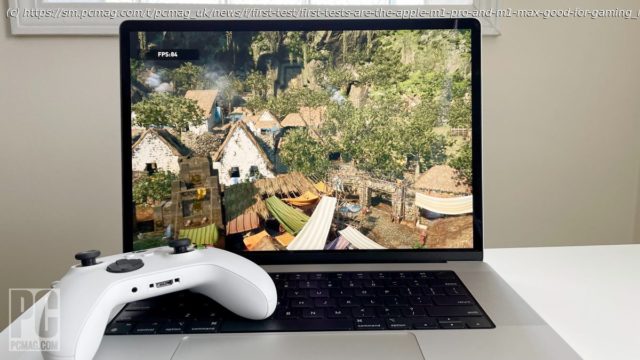The M1 Pro and Max CPUs in the latest MacBook Pros are all about muscle for content creators—but those folks like to have fun, too! We tested the M1 graphics with a host of Mac games to see how they run.
For decades, Apple has used third-party graphics processors in many of its laptops and desktops, from the humble Nvidia GeForce 9400M in early MacBooks to the muscular AMD Radeon Pro 5700 XT in the latest 27-inch iMac. The newest MacBook Pro laptops, by contrast, use Apple’s M1 Pro and M1 Max, custom-designed SoCs that combine CPU and GPU duties and share a pool of memory, to handle graphics output and acceleration. Seeing how well they perform on CPU-intensive workflows when we reviewed the 14-inch and 16-inch MacBook Pros got us thinking: Are these seriously powerful new processors equally adept at running graphics-intensive AAA games? It’s a fraught question. Apple makes it clear that its flagship MacBook Pro laptops are optimized for heavy-duty content creation, not gaming. And most game developers have overlooked macOS as a serious gaming platform, focusing instead on consoles and Windows. This chicken-and-egg situation means that even if the GPU portions of the M1 Pro and M1 Max are theoretically as capable as (or better than) the AMD Radeon or integrated Intel silicon they replace in past MacBooks, you still don’t have an extensive game selection to take advantage of. Hitman (2016) Still, a gamer can dream. So we ran a handful of graphics-intensive games (and a few less-demanding titles) released in the past few years on both the M1 Pro-equipped 14-inch MacBook Pro and the M1 Max-equipped 16-inch MacBook Pro to see what they are capable of. M1 Game Testing: Picking the Titles Many of the AAA titles compatible with Macs come from British developer Feral Interactive, which partners with studios to bring their creations to platforms other than Windows. Among the most graphics-intensive Mac titles in our benchmark suite are the Tomb Raider series, from which we ran the built-in benchmarks in Rise of the Tomb Raider and Shadow of the Tomb Raider. These are older games, to be sure. We also tested out a Total War game ( Total War: Warhammer II), the Hitman reboot from 2016, and Sid Meier’s Civilization VI. The last game has far lesser demands on a computer’s graphics power than the rest of the lot, so we used its built-in benchmark for simulating how long it takes the AI to complete a turn, for a different perspective on game performance. All games were run at a full-HD-equivalent resolution (1,920 by 1,200 pixels) because the two new MacBook Pros have differing native display resolutions. (Testing at each laptop’s native resolution would have rendered the scores non-comparable.) We also ran three graphics simulations: the cutting-edge 3DMark (specifically the Wild Life graphics simulation, recently released and compatible with macOS and Windows) and GFXBench Pro, as well as the older Unigine Valley test. These render scenes of richly detailed gaming-style graphics as a means to compare relative performance across devices with different operating systems. GFXBench renders the scenes without displaying them on the screen, and 3DMark renders them in a window, to account for resolution differences automatically, while we ran the Valley test at the same 1,920 by 1,200 pixels that we ran the games at. We also ran a subset of these games and synthetic tests on a GeForce RTX 3070-equipped gaming laptop we are in the process of reviewing: the Razer Blade 15 Advanced Edition.






